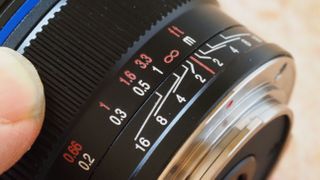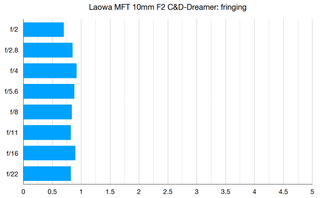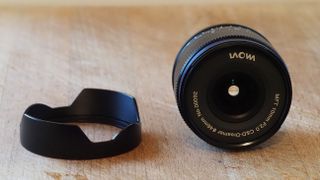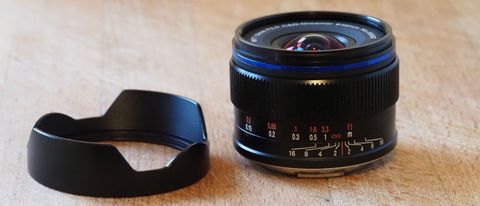The Laowa 10mm f/2 Zero-D is made specifically for Micro Four Thirds cameras from Olympus and Panasonic, and fills a niche gap in the lens ecosystem.
While the Laowa 10mm f/2 Zero-D isn't the widest lens for the format (with the likes of the Laowa 4mm f/2.8 Fisheye and Olympus M.Zuiko 8mm f/1.8 Fisheye Pro out there), it is the widest non-fisheye – one that boasts the titular Zero Distortion and an amazingly fast f/2 maximum aperture.
Laowa has still yet to embrace autofocus, but this lens does now have a chip that can communicate with the camera and automatically trigger the camera’s manual focus aid (typically zooming in) when you try the focus ring.
That’s not all. It also has an aperture drive motor, so that you can control the lens aperture from the camera. This means the Laowa is a step up from a typical ‘dumb’ prime and can be used in program AE and shutter priority modes, not just manual and aperture priority.

Specifications
Focal Length: 10mm (20mm equivalent)
Max. Aperture: f/2
Min. Aperture: f/22
Angle of View: 96 degrees
Lens Construction: 11 Elements in 7 groups
Aperture Blades: 5
Min. Focus Distance: 12cm
Dimensions: 54mmx41mm
Weight: 125g
Filter Size: 46mm
Key features

The internal chip and aperture motor make this lens a bit of a departure for Laowa. It establishes much better communication between the camera and the lens and unlocks a wider range of exposure modes.
There is a downside. Because the aperture can be controlled by the camera, Laowa has not included a manual aperture ring and these – to be honest – have always been a big part of this brand’s appeal.
However, the little Laowa makes up for it in other ways. The f/2 maximum aperture is just one, and in conjunction with the IBIS in Olympus and Panasonic MFT bodies, this makes it perfect for low-light interiors.
It can also focus extremely close, right down to just 12cm. Laowa has made a bit of a thing about ultra-close focusing wide angles to really exaggerate the perspective of nearby objects against their backgrounds, and this close-focusing capability is really useful to have.
When you combine this with the f/2 maximum aperture, you get a lens which can deliver a lot more background blur than you might expect from an ultra-wide lens on the small MFT format.
Build and handling

The Laowa 10mm f/2 Zero-D is by no means expensive, but this is by no means a ‘cheap’ lens in its feel and handling. It’s about the same size as the Olympus 17mm f/2.8 prime, but if anything it feels better made, smoother in operation and more solid. From the metal mounting plate to the included petal lens hood, this lens is a quality piece of kit.
It’s not quite perfect, though. Turning the focus ring activates the camera’s own focus aid, but it’s a little too sensitive. It’s too easy to touch or nudge the ring simply as you handle the camera. Also, while the focus ring has a long travel and a precise-looking distance scale, the infinity marking does not exactly align with infinity focus in the viewfinder. This is a lens where you might be tempted to rely on the distance scale and depth of field markings for zone or hyperfocal focusing, so it’s a shame it’s not just a tiny bit more accurate.
Worse, the focus ring turns past the infinity marker, so you can’t just turn it to its end stop by feel and assume that’s ‘infinity’.
These two characteristics do take the edge off the fun factor just a little, but that aside, this is a beautifully made little lens that’s just a joy to use, when you have a focus ring as smooth as this.
Performance




We’ve used Laowa’s Zero-D lenses before and this one is like the rest and really does deliver zero distortion – or so close to zero that it hardly matters. And, unlike the 9mm f/2.8 Zero-D for APS-C cameras, there’s negligible vignetting, either.
In real-world shots of subjects at normal distances (not test charts), the Laowa 10mm f/2 Zero-D delivers excellent edge to edge sharpness too, and almost no chromatic aberration. What a great little lens!
The lab tests do reveal a drop off in sharpness towards the edges of the frame, but with ultra-wide lenses our lab charts have to be shot at very short focus distances – in real-world shots any drop-off in sharpness at the frame edges is harder to spot.
Lab data
We run a range of lab tests under controlled conditions, using the Imatest Master testing suite. Photos of test charts are taken across the range of apertures and zooms (where available), then analyzed for sharpness, distortion and chromatic aberrations.
We use Imatest SFR (spatial frequency response) charts and analysis software to plot lens resolution at the centre of the image frame, corners and mid-point distances, across the range of aperture settings and, with zoom lenses, at four different focal lengths. The tests also measure distortion and color fringing (chromatic aberration).
Sharpness:

Center sharpness is excellent, right from wide open at f/2, through to f/8. Inevitably for a wide angle lens, corner sharpness is less impressive, as the lens has to be positioned very close to our sharpness test chart. However, we'd still have expected slightly better corner sharpness than this (especially at f/2.8 and f/4) given a 20mm-equivalent focal length isn't that wide.
Fringing:

Distortion: -0.64
A negative score indicates barrel distortion, a positive score pincushion. A score of zero signifies no distortion.
There is just a touch of barrel distortion, but the Laowa Zero-D lives up to its name. It's not an Olympus lens, so we assume the camera is not applying any in-camera distortion correction, which makes the result even more impressive – especially as there's relatively little corner shading too.
Verdict

The Laowa 10mm f/2 Zero-D delivers excellent optical performance for a lens of this type, a really useful maximum aperture and minimum focus distance, and a build quality that makes its modest price all the more remarkable.
It’s great to see Laowa using electronics to make this lens communicate better with the camera – that’s really useful – though it’s a shame the aperture ring has been lost and we wish the focus scale was a bit more accurate with a proper ‘infinity’ end stop.
But these are quibbles when set against this lens’s performance, handling and price. If you have an MFT camera and need a lens that’s wide, affordable and portable, this is it – just don’t forget to focus!
Read more:
• Best Micro Four Thirds lenses
• Best Olympus cameras
• Best Panasonic cameras
• Best travel cameras
• Best mirrorless cameras


